Developing Further Versatility in Benzoxazine Synthesis via Hydrolytic Ring-Opening
Abstract
1. Introduction
2. Experimental
2.1. Materials
2.2. Monomer Synthesis
2.2.1. Synthesis of 3-Phenyl-3,4-dihydro-2H-benzo[e] [1,3]-oxazine (abbreviated as PH-a)
2.2.2. Synthesis of 6,6’-(propane-2,2-diyl)bis(3-phenyl-3,4-dihydro-2H-benzo[e][1,3]oxazine) (abbreviated as BA-a)
2.2.3. Synthesis of 2-((phenylamino)methyl)phenol (abbreviated as hPH-a)
2.2.4. Synthesis of 4,4’-(propane-2,2-diyl)bis(2-((phenylamino)methyl)phenol) (abbreviated as hBA-a)
2.2.5. Resynthesis of PH-a and BA-a from hPH-a and hBA-a
2.2.6. Synthesis of 2,3-diphenyl-3,4-dihydro-2H-benzo[e][1,3]oxazine ((abbreviated as PH-a-[2]ba)
2.3. Characterization
3. Results and Discussion
4. Conclusions
Author Contributions
Funding
Acknowledgments
Conflicts of Interest
References
- Nair, C.P.R. Advances in addition-cure phenolic resins. Prog. Polym. Sci. 2004, 29, 401–498. [Google Scholar] [CrossRef]
- Takeichi, T.; Agag, T. High performance polybenzoxazines as novel thermosets. High Perform. Polym. 2006, 18, 777–797. [Google Scholar]
- Ghosh, N.N.; Kiskan, B.; Yagci, Y. Polybenzoxazines-new high performance thermosetting resins: Synthesis and properties. Prog. Polym. Sci. 2007, 32, 1344–1391. [Google Scholar] [CrossRef]
- Ishida, H. Overview and historical background of polybenzoxazine research. In Handbook of Benzoxazine Resins; Elsevier: Amsterdam, The Netherlands, 2011; pp. 3–81. [Google Scholar]
- Rimdusit, S.; Jubsilp, C.; Tiptipakorn, S. Alloys and Composites of Polybenzoxazines; Springer: Berlin/Heidelberg, Germany, 2013. [Google Scholar]
- Ishida, H.; Froimowicz, P. Advanced and Emerging Polybenzoxazine Science and Technology; Elsevier: Amsterdam, The Netherlands, 2017. [Google Scholar]
- Kiskan, B. Adapting benzoxazine chemistry for unconventional applications. React. Funct. Polym. 2018, 129, 76–88. [Google Scholar] [CrossRef]
- Ishida, H.; Allen, D.J. Physical and mechanical characterization of near-zero shrinkage polybenzoxazines. J. Polym. Sci. Part B Polym. Phys. 1996, 34, 1019–1030. [Google Scholar] [CrossRef]
- Shen, S.B.; Ishida, H. Dynamic mechanical and thermal characterization of high-performance polybenzoxazines. J. Polym. Sci. Part B Polym. Phys. 1999, 37, 3257–3268. [Google Scholar] [CrossRef]
- Espinosa, M.; Galia, M.; Cadiz, V. Novel phosphorilated flame retardant thermosets: Epoxy–benzoxazine–novolac systems. Polymer 2004, 45, 6103–6109. [Google Scholar] [CrossRef]
- Lin, C.H.; Cai, S.X.; Leu, T.S.; Hwang, T.Y.; Lee, H.H. Synthesis and properties of flame-retardant benzoxazines by three approaches. J. Polym. Sci. Part A Polym. Chem. 2006, 44, 3454–3468. [Google Scholar] [CrossRef]
- Yan, H.; Wang, H.; Fang, Z. Flame-retarding modification for ramie/benzoxazine laminates and the mechanism study. Ind. Eng. Chem. Res. 2014, 53, 19961–19969. [Google Scholar] [CrossRef]
- Sonnier, R.; Otazaghine, B.; Dumazert, L.; Ménard, R.; Viretto, A.; Dumas, L.; Bonnaud, L.; Dubois, P.; Safronava, N.; Walters, R. Prediction of thermosets flammability using a model based on group contributions. Polymer 2017, 127, 203–213. [Google Scholar] [CrossRef]
- Liu, J.; Safronava, N.; Lyon, R.E.; Maia, J.; Ishida, H. Enhanced Thermal Property and Flame Retardancy via Intramolecular 5-Membered Ring Hydrogen Bond-Forming Amide Functional Benzoxazine Resins. Macromolecules 2018, 51, 9982–9991. [Google Scholar]
- Ishida, H.; Rodriguez, Y. Catalyzing the curing reaction of a new benzoxazine-based phenolic resin. J. Appl. Polym. Sci. 1995, 58, 1751–1760. [Google Scholar] [CrossRef]
- Ishida, H.; Low, H.Y. A study on the volumetric expansion of benzoxazine-based phenolic resin. Macromolecules 1997, 30, 1099–1106. [Google Scholar]
- Liu, X.; Gu, Y. Study on the volumetric change during ring-opening polymerization of benzoxazines. Acta Polym. Sin. 2000, 5. [Google Scholar]
- Su, Y.-C.; Chang, F.-C. Synthesis and characterization of fluorinated polybenzoxazine material with low dielectric constant. Polymer 2003, 44, 7989–7996. [Google Scholar] [CrossRef]
- Velez-Herrera, P.; Doyama, K.; Abe, H.; Ishida, H. Synthesis and characterization of highly fluorinated polymer with the benzoxazine moiety in the main chain. Macromolecules 2008, 41, 9704–9714. [Google Scholar]
- Tseng, M.-C.; Liu, Y.-L. Preparation, morphology, and ultra-low dielectric constants of benzoxazine-based polymers/polyhedral oligomeric silsesquioxane (POSS) nanocomposites. Polymer 2010, 51, 5567–5575. [Google Scholar] [CrossRef]
- Vengatesan, M.; Devaraju, S.; Kumar, A.A.; Alagar, M. Studies on thermal and dielectric properties of Octa (maleimido phenyl) silsesquioxane (OMPS)-polybenzoxazine (PBZ) hybrid nanocomposites. High Perform. Polym. 2011, 23, 441–456. [Google Scholar]
- Zhang, K.; Zhuang, Q.; Zhou, Y.; Liu, X.; Yang, G.; Han, Z. Preparation and properties of novel low dielectric constant benzoxazole-based polybenzoxazine. J. Polym. Sci. Part A Polym. Chem. 2012, 50, 5115–5123. [Google Scholar]
- Sethuraman, K.; Alagar, M. Thermo-mechanical and dielectric properties of graphene reinforced caprolactam cardanol based benzoxazine–epoxy nanocomposites. RSC Adv. 2015, 5, 9607–9617. [Google Scholar]
- Xu, Q.; Zeng, M.; Chen, J.; Zeng, S.; Huang, Y.; Feng, Z.; Xu, Q.; Yan, C.; Gu, Y. Synthesis, polymerization kinetics, and high-frequency dielectric properties of novel main-chain benzoxazine copolymers. React. Funct. Polym. 2018, 122, 158–166. [Google Scholar] [CrossRef]
- Chen, J.; Zeng, M.; Feng, Z.; Pang, T.; Huang, Y.; Xu, Q. Design and Preparation of Benzoxazine Resin with High-Frequency Low Dielectric Constants and Ultralow Dielectric Losses. ACS Appl. Polym. Mater. 2019, 1, 625–630. [Google Scholar] [CrossRef]
- Wang, C.F.; Su, Y.C.; Kuo, S.W.; Huang, C.F.; Sheen, Y.C.; Chang, F.C. Low-surface-free-energy materials based on polybenzoxazines. Angew. Chem. Int. 2006, 45, 2248–2251. [Google Scholar] [CrossRef] [PubMed]
- Chen, K.C.; Li, H.T.; Huang, S.C.; Chen, W.B.; Sun, K.W.; Chang, F.C. Synthesis and performance enhancement of novel polybenzoxazines with low surface free energy. Polym. Int. 2011, 60, 1089–1096. [Google Scholar] [CrossRef]
- Qu, L.; Xin, Z. Preparation and surface properties of novel low surface free energy fluorinated silane-functional polybenzoxazine films. Langmuir 2011, 27, 8365–8370. [Google Scholar] [CrossRef]
- Lin, C.H.; Chang, S.L.; Shen, T.Y.; Shih, Y.S.; Lin, H.T.; Wang, C.F. Flexible polybenzoxazine thermosets with high glass transition temperatures and low surface free energies. Polym. Chem. 2012, 3, 935–945. [Google Scholar] [CrossRef]
- Selvi, M.; Vengatesan, M.; Devaraju, S.; Kumar, M.; Alagar, M. In situ sol–gel synthesis of silica reinforced polybenzoxazine hybrid materials with low surface free energy. RSC Adv. 2014, 4, 8446–8452. [Google Scholar] [CrossRef]
- Ishida, H.; Agag, T. Handbook of Benzoxazine Resins; Elsevier: Amsterdam, The Netherlands, 2011. [Google Scholar]
- RoyáJackson, W. Allylic rearrangements during the rhodium-catalysed reactions of 2-allyloxybenzylamines and 2-(N-allyl-N-benzylamino) benzylamine. J. Chem. Soc. Chem. Commun. 1994, 2763. [Google Scholar]
- Campi, E.M.; Jackson, W.R.; Mccubbin, Q.J.; Trnacek, A.E. The stereochemistry of organometallic compounds. XLIII. Rhodium-catalysed reactions of 2-(alkenyloxy) benzylamines and 2-(N-Allyl-N-benzylamino) benzylamine. Aust. J. Chem. 1996, 49, 219–230. [Google Scholar] [CrossRef]
- Tang, Z.; Chen, W.; Zhu, Z.; Liu, H. Synthesis of 2, 3-diaryl-3, 4-dihydro-2H-1, 3-benzoxazines and their fungicidal activities. J. Heterocycl. Chem. 2011, 48, 255–260. [Google Scholar] [CrossRef]
- Tang, Z.; Zhu, Z.; Xia, Z.; Liu, H.; Chen, J.; Xiao, W.; Ou, X. Synthesis and fungicidal activity of novel 2, 3-disubstituted-1, 3-benzoxazines. Molecules 2012, 17, 8174–8185. [Google Scholar] [CrossRef] [PubMed]
- Tang, Z.; Chen, W.; Zhu, Z.; Liu, H. SnCl4-Catalyzed Aza-Acetalization of Aromatic Aldehydes: Synthesis of Aryl Substituted 3, 4-Dihydro-2H-1, 3-benzoxazines. Synth. Commun. 2012, 42, 1372–1383. [Google Scholar] [CrossRef]
- Ohashi, S.; Cassidy, F.; Huang, S.; Chiou, K.; Ishida, H. Synthesis and ring-opening polymerization of 2-substituted 1, 3-benzoxazine: The first observation of the polymerization of oxazine ring-substituted benzoxazines. Polym. Chem. 2016, 7, 7177–7184. [Google Scholar] [CrossRef]
- Burke, W.J. 3, 4-Dihydro-1, 3, 2H-Benzoxazines. Reaction of p-substituted phenols with N,N-dimethylolamines. J. Am. Chem. Soc. 1949, 71, 609–612. [Google Scholar] [CrossRef]
- Sainsbury, M. Comprehensive Heterocyclic Chemistry. In Oxazines, Thiazines and their Benzo Derivatives; Elsevier: Amsterdam, The Netherlands, 1984; pp. 995–1038. [Google Scholar]
- Yang, X.-F.; Hirose, T.; Zhang, G.-Y. Synthesis of novel chiral tridentate aminophenol ligands for enantioselective addition of diethylzinc to aldehydes. Tetrahedron Asymmetry 2008, 19, 1670–1675. [Google Scholar] [CrossRef]
- Han, L.; Salum, M.L.; Zhang, K.; Froimowicz, P.; Ishida, H. Intrinsic self-initiating thermal ring-opening polymerization of 1, 3-benzoxazines without the influence of impurities using very high purity crystals. J. Polym. Sci. Part A Polym. Chem. 2017, 55, 3434–3445. [Google Scholar] [CrossRef]
- Ning, X.; Ishida, H. Phenolic materials via ring-opening polymerization of benzoxazines: Effect of molecular structure on mechanical and dynamic mechanical properties. J. Polym. Sci. Part B Polym. Phys. 1994, 32, 921–927. [Google Scholar] [CrossRef]
- Dunkers, J.; Ishida, H. Vibrational assignments of 3-alkyl-3, 4-dihydro-6-methyl-2H-1, 3-benzoxazines in the fingerprint region. Spectrochim. Acta Part A Mol. Biomol. Spectrosc. 1995, 51, 1061–1074. [Google Scholar] [CrossRef]
- Dunkers, J.; Ishida, H. Vibrational assignments of N, N-bis (3, 5-dimethyl-2-hydroxybenzyl) methylamine in the fingerprint region. Spectrochim. Acta Part A Mol. Biomol. Spectrosc. 1995, 51, 855–867. [Google Scholar] [CrossRef]
- Han, L.; Iguchi, D.; Gil, P.; Heyl, T.R.; Sedwick, V.M.; Arza, C.R.; Ohashi, S.; Lacks, D.J.; Ishida, H. Oxazine ring-related vibrational modes of benzoxazine monomers using fully aromatically substituted, deuterated, 15N isotope exchanged, and oxazine-ring-substituted compounds and theoretical calculations. J. Phys. Chem. A 2017, 121, 6269–6282. [Google Scholar] [CrossRef]

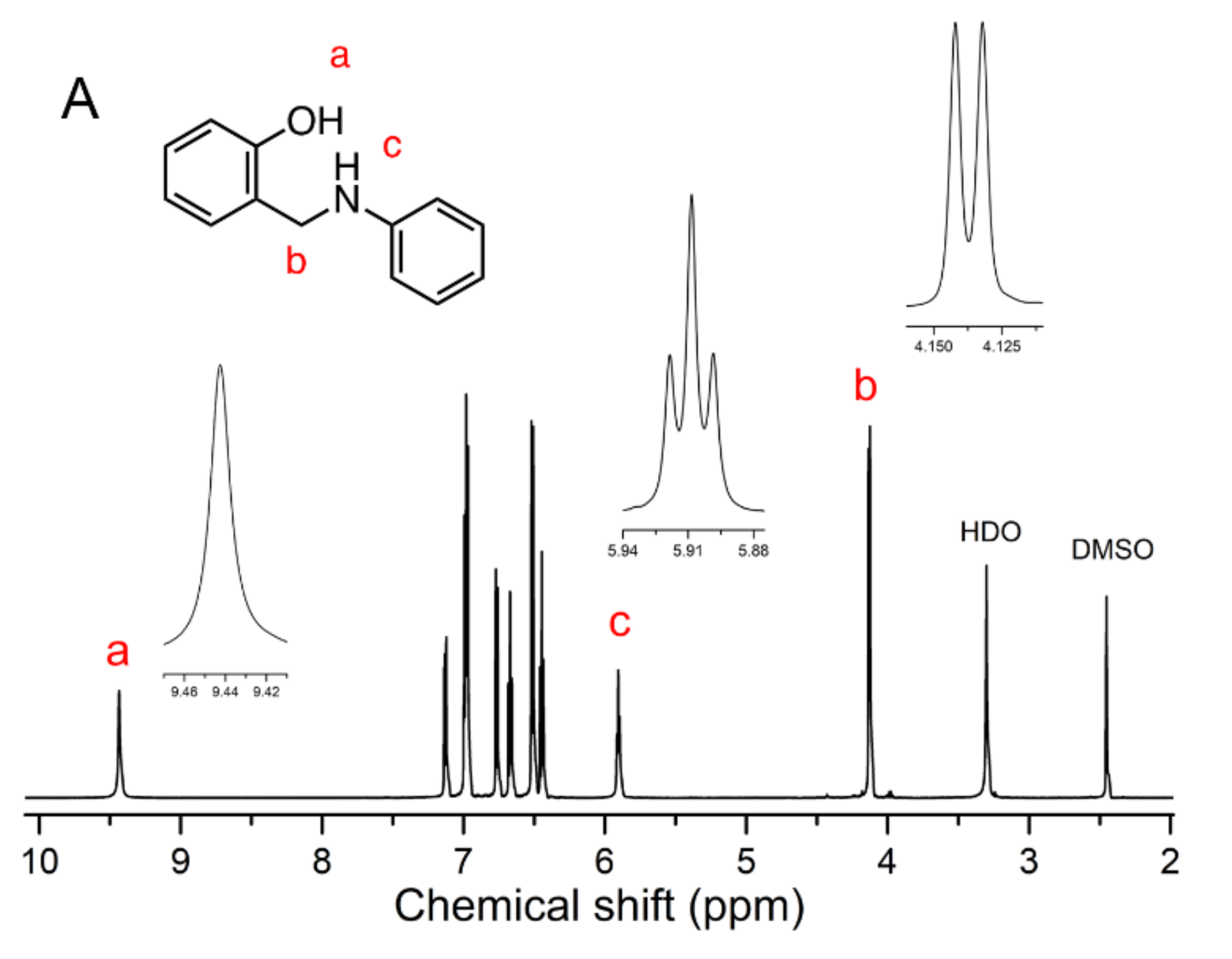
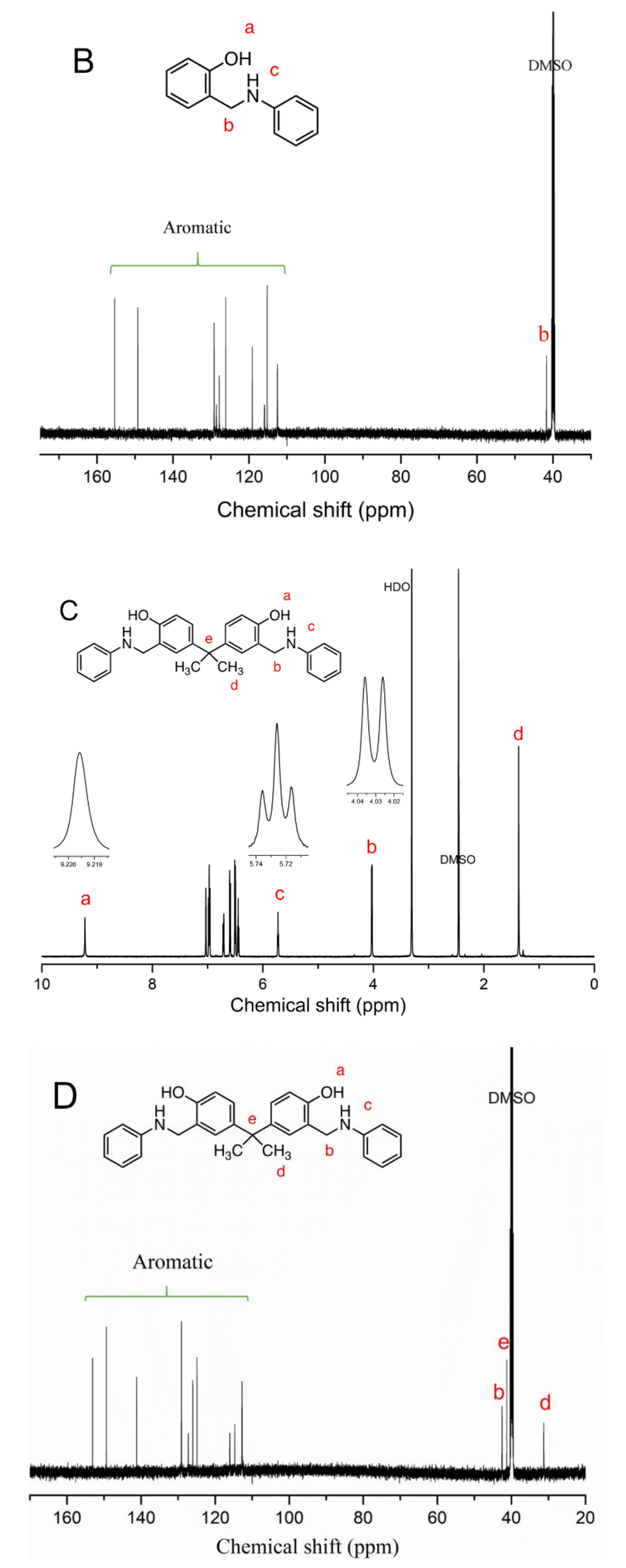
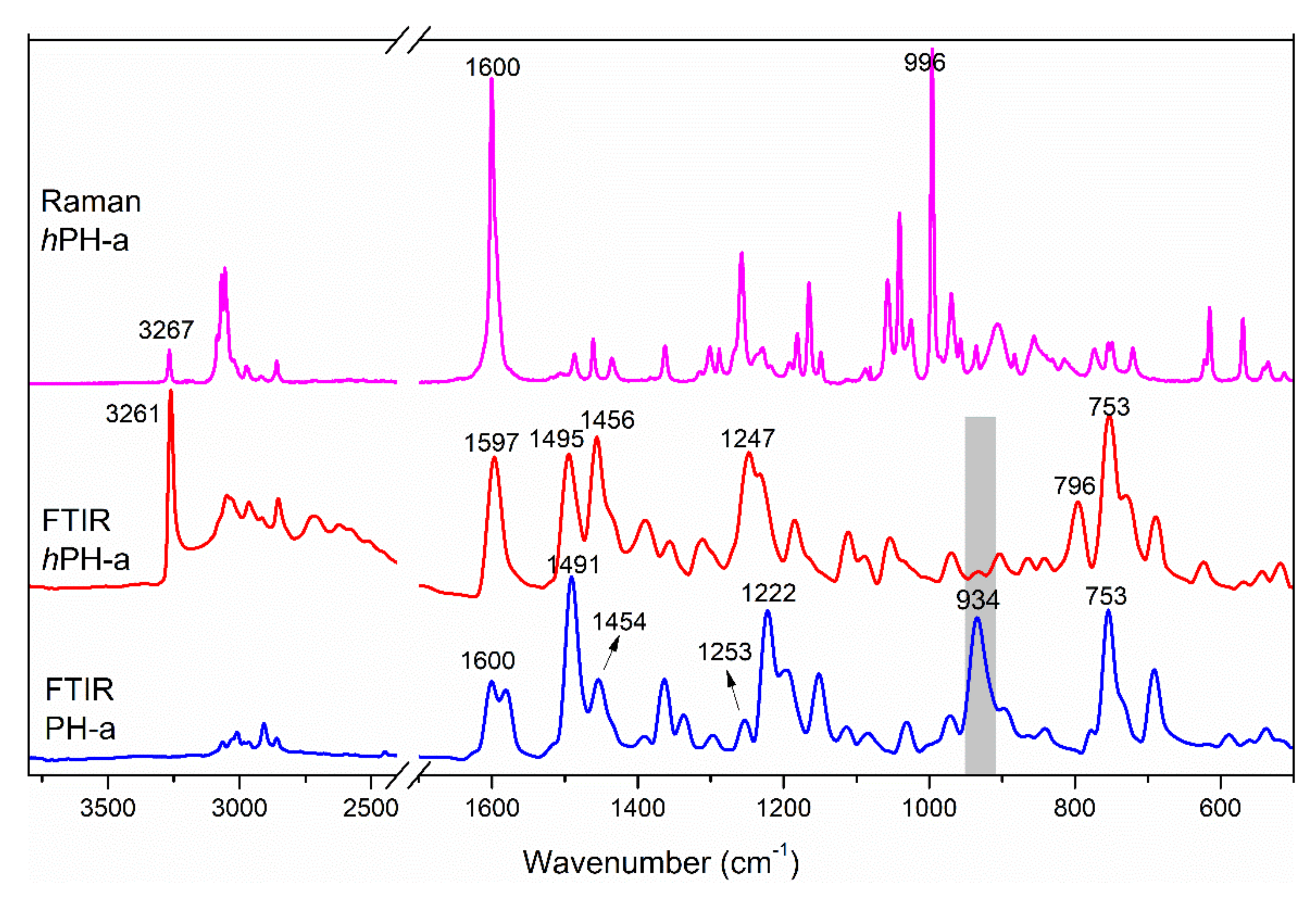
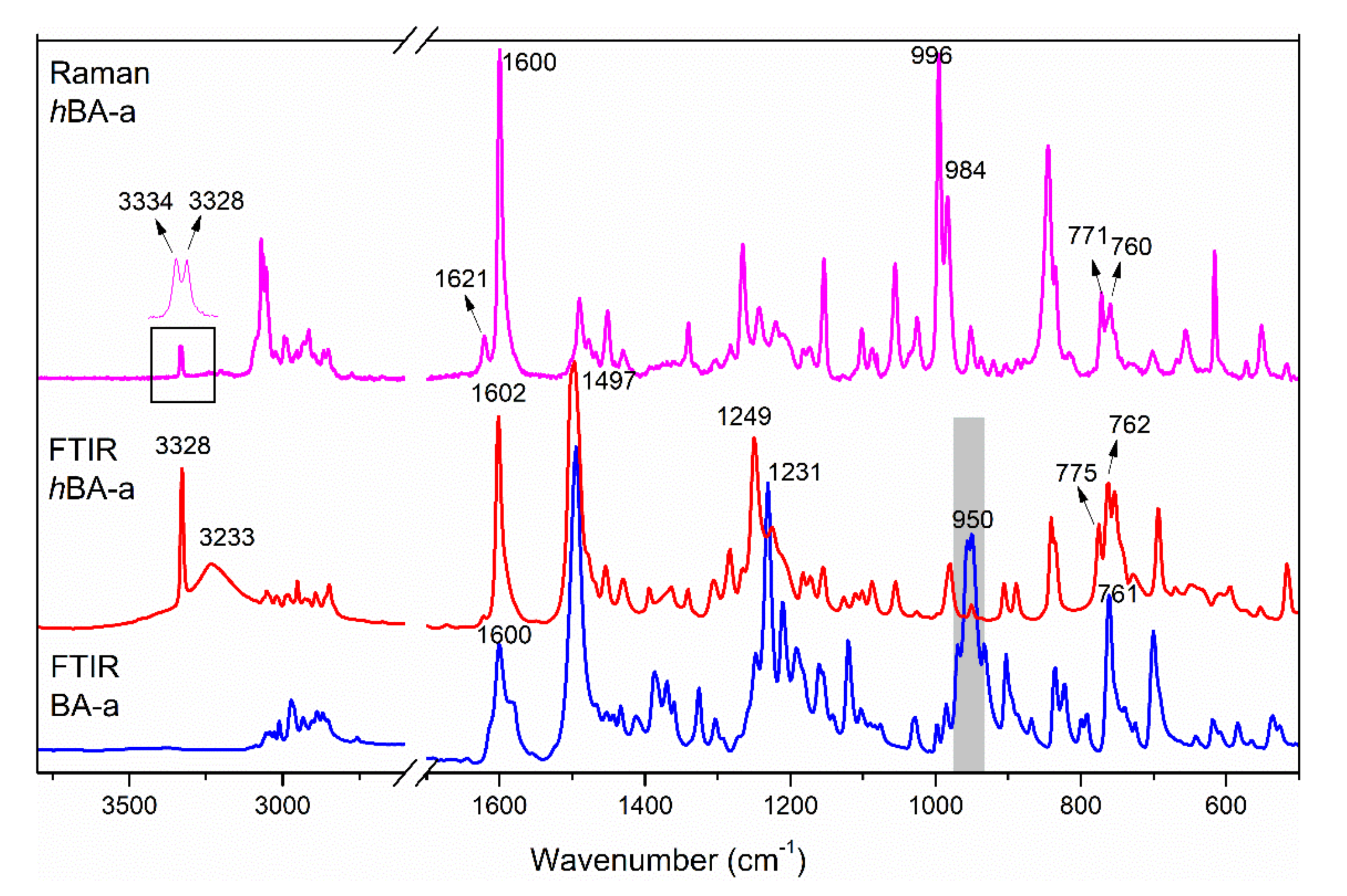
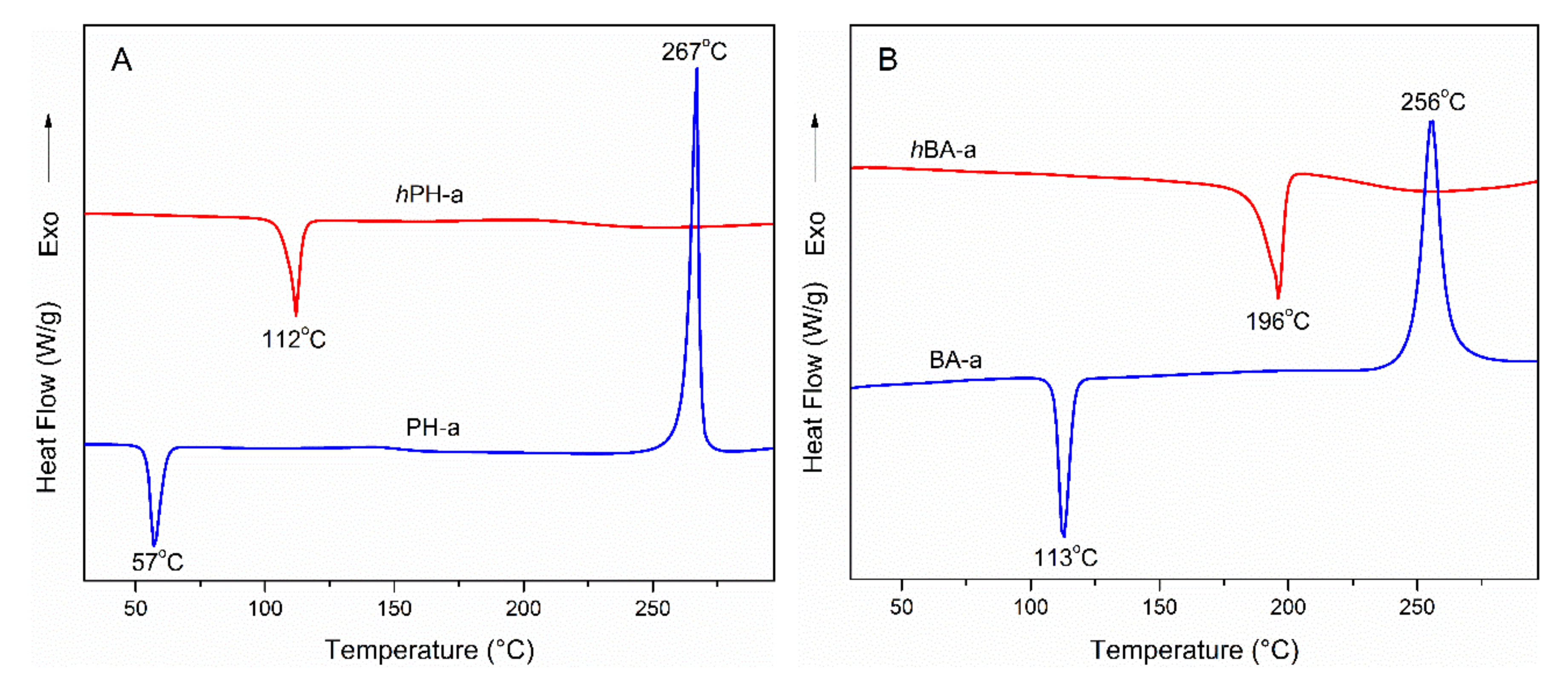

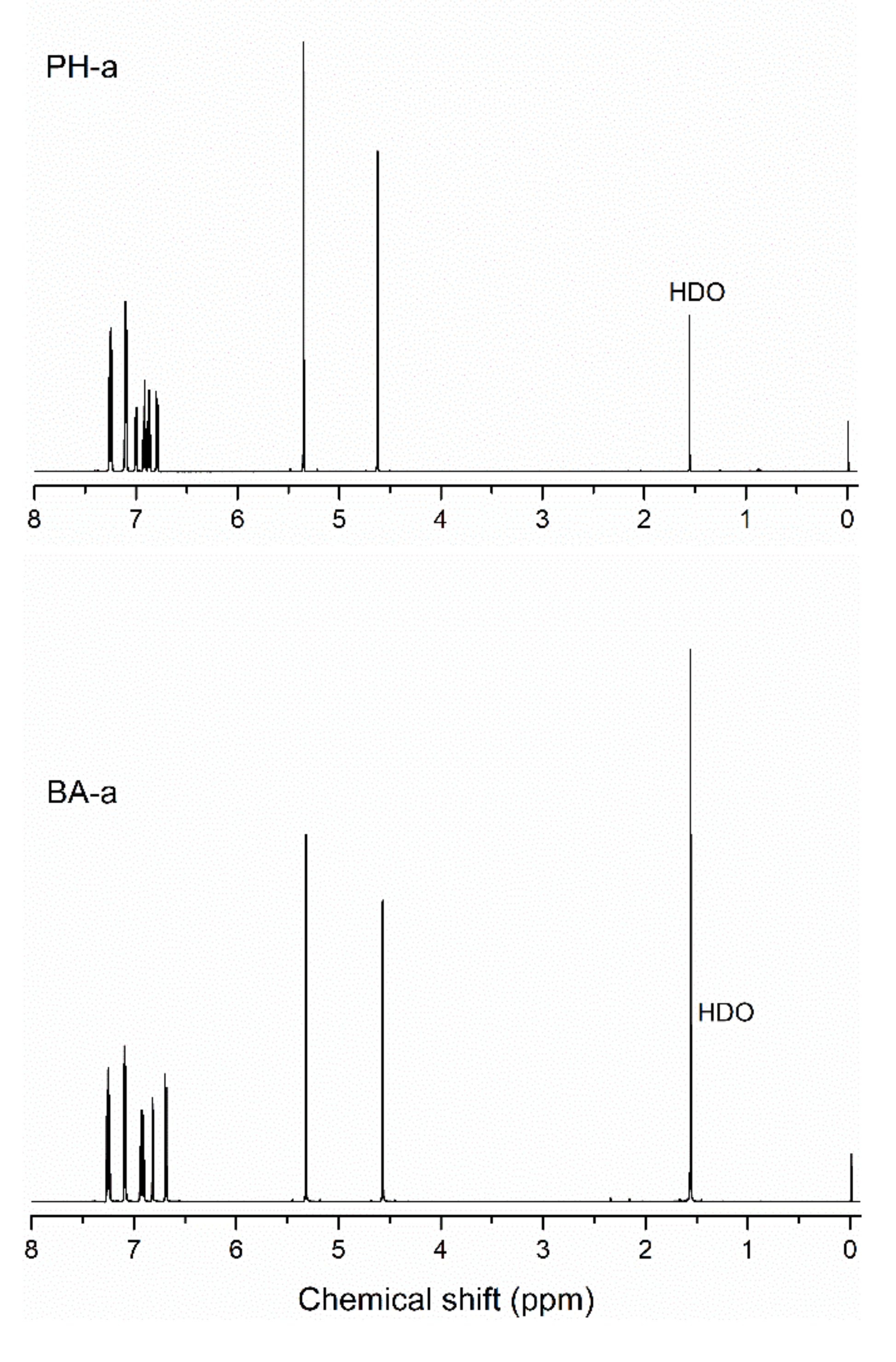

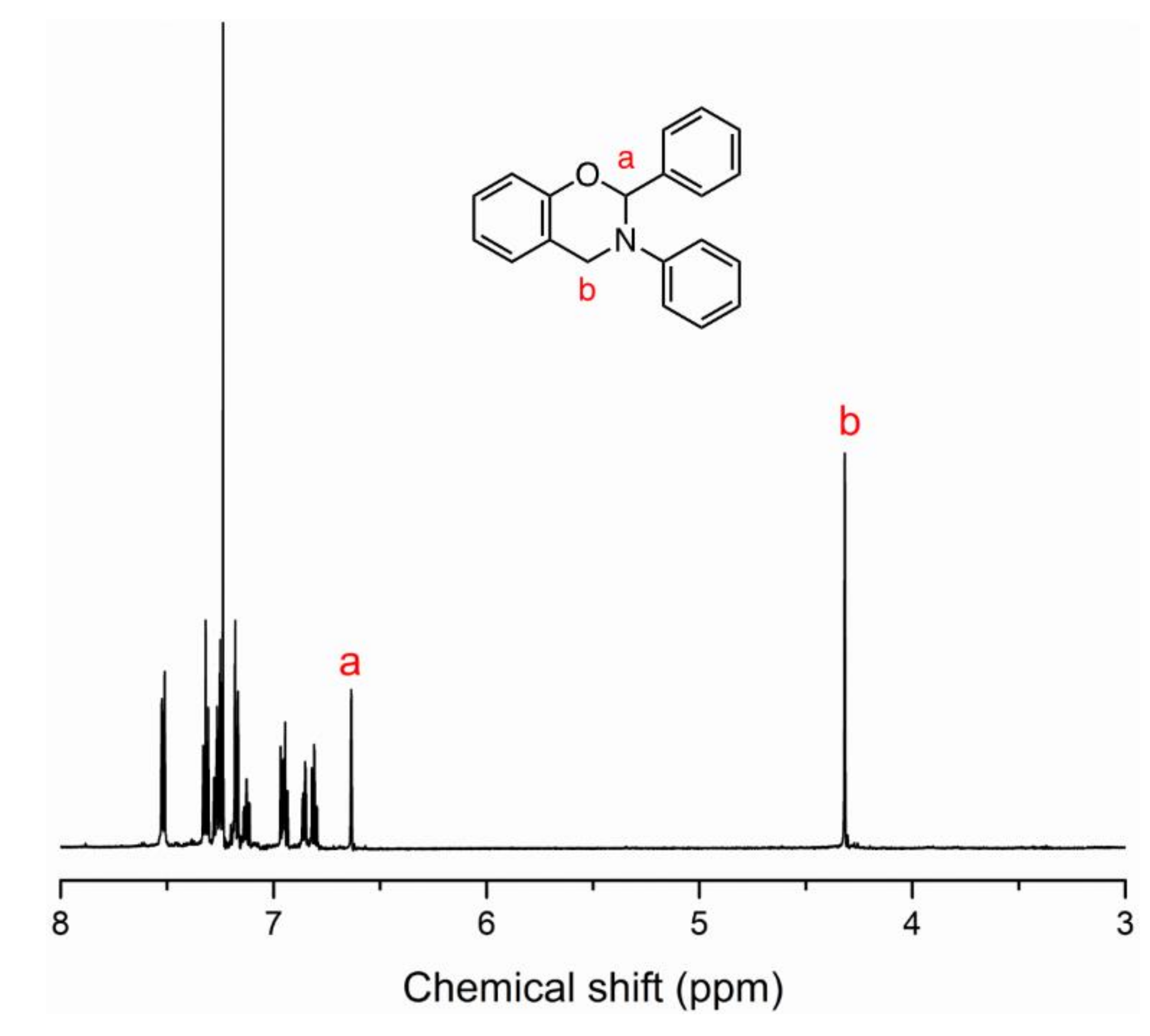
| C | H | N | ||||
|---|---|---|---|---|---|---|
| Theoretical | Experimental | Theoretical | Experimental | Theoretical | Experimental | |
| hPH-a | 78.39% | 78.26% | 6.53% | 6.51% | 7.04% | 6.87% |
| hBA-a | 79.45% | 79.33% | 6.85% | 6.57% | 6.39% | 6.09% |
© 2020 by the authors. Licensee MDPI, Basel, Switzerland. This article is an open access article distributed under the terms and conditions of the Creative Commons Attribution (CC BY) license (http://creativecommons.org/licenses/by/4.0/).
Share and Cite
Cui, S.; Arza, C.R.; Froimowicz, P.; Ishida, H. Developing Further Versatility in Benzoxazine Synthesis via Hydrolytic Ring-Opening. Polymers 2020, 12, 694. https://doi.org/10.3390/polym12030694
Cui S, Arza CR, Froimowicz P, Ishida H. Developing Further Versatility in Benzoxazine Synthesis via Hydrolytic Ring-Opening. Polymers. 2020; 12(3):694. https://doi.org/10.3390/polym12030694
Chicago/Turabian StyleCui, Shaoying, Carlos R. Arza, Pablo Froimowicz, and Hatsuo Ishida. 2020. "Developing Further Versatility in Benzoxazine Synthesis via Hydrolytic Ring-Opening" Polymers 12, no. 3: 694. https://doi.org/10.3390/polym12030694
APA StyleCui, S., Arza, C. R., Froimowicz, P., & Ishida, H. (2020). Developing Further Versatility in Benzoxazine Synthesis via Hydrolytic Ring-Opening. Polymers, 12(3), 694. https://doi.org/10.3390/polym12030694







